
From Community College to Graduate and Professional Degrees – 2017
Community colleges provide an important entry point on the pathway to graduate and professional degree completion. Nearly 20 percent of 2016-17 master’s degree earners originally entered higher education in a community college, and nearly 12 percent earned an associate degree from a community college.
From Community College to Master’s Degree
Students who earned master’s degrees in health and clinical sciences were most likely to have entered higher education in a community college. Over 26 percent of master’s degree earners in this field entered higher education in a community college, while 18.5 percent earned an associate degree from a community college.
In contrast, only nine percent of master’s degree earners in science and engineering originally entered higher education in a community college.
Note: Counts of students who earned associate degrees from a community college are not limited to students who entered higher education at a community college.
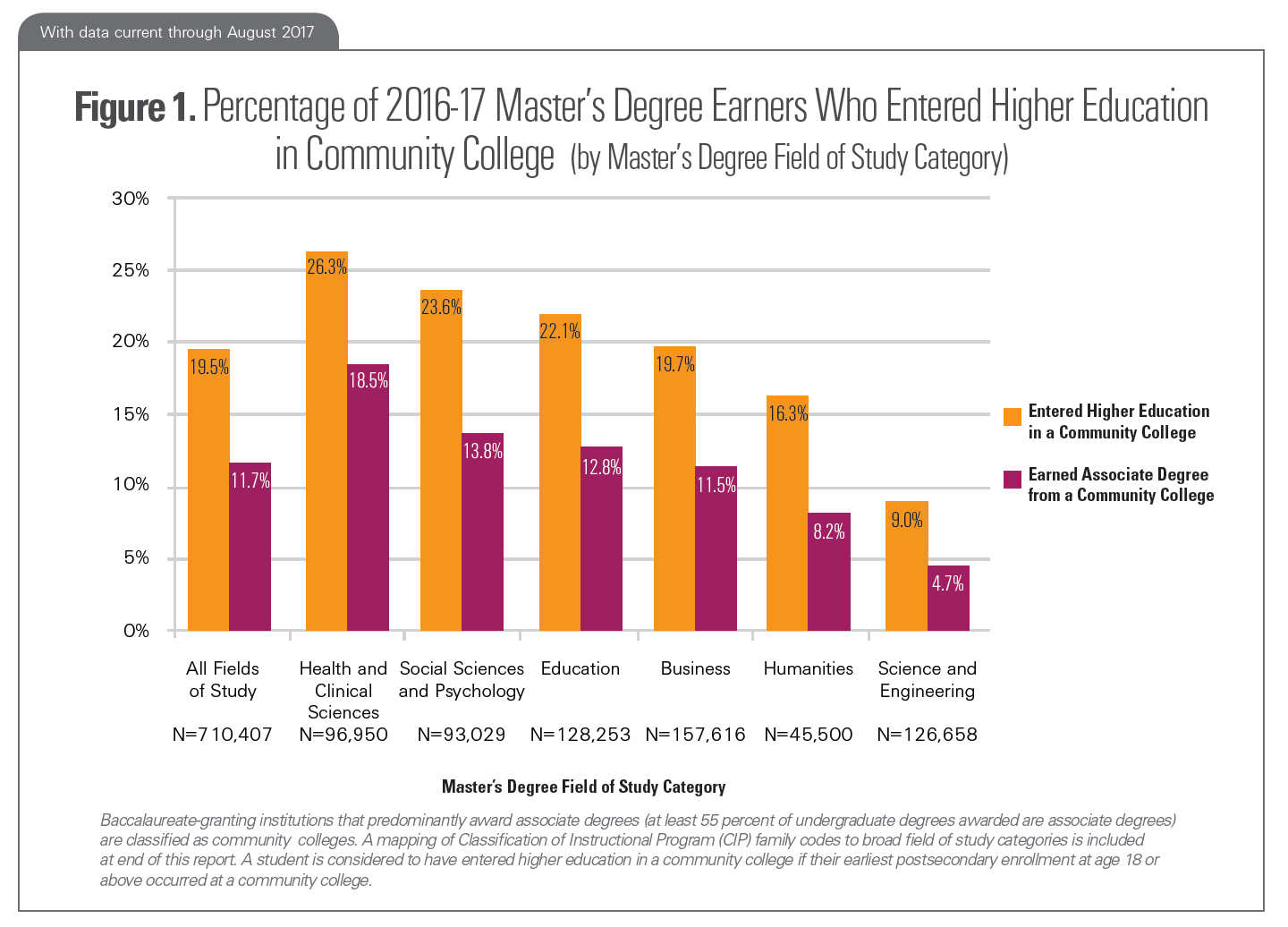
Years from Associate to Master’s Degree
For students who earned both an associate degree and a master’s degree, an average of nearly 10 years separated the completion dates of the two credentials.
The longest average timespans from associate to master’s were in education (10.7 years), health and clinical sciences (10.5 years), and business (10.0 years), suggesting that students often earn master’s degrees in these fields after various periods of part-time study or non-enrollment.
The shortest average timespans from associate to master’s were in social sciences and psychology (8.5 years) and science and engineering (9.0 years).
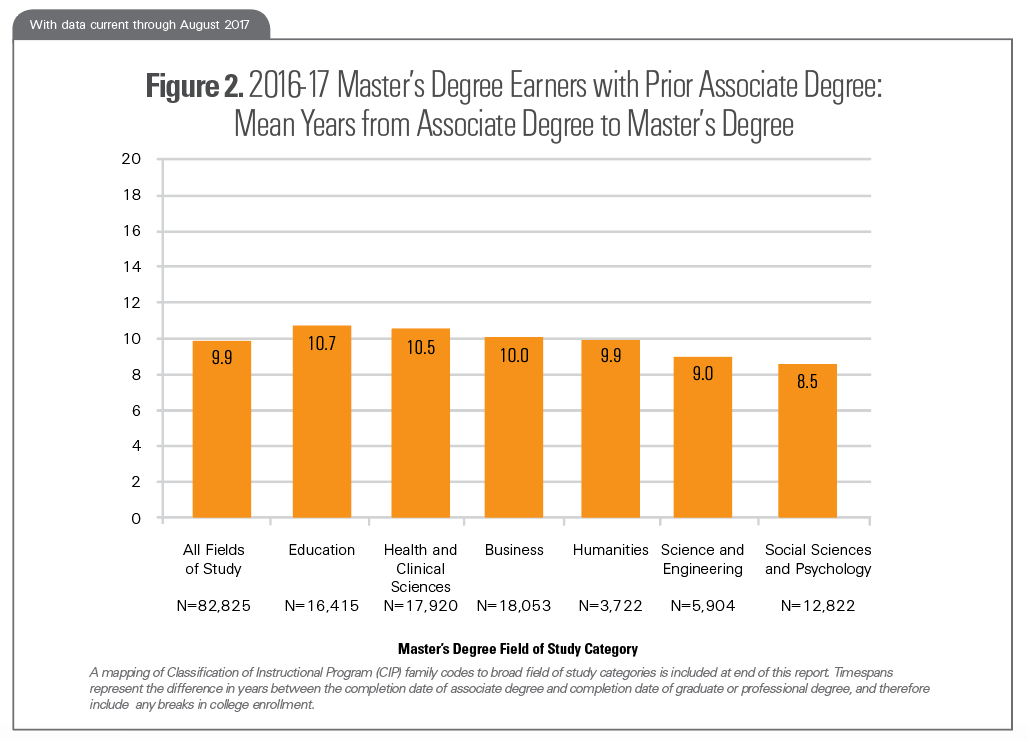
From Community College to Doctoral-Research Degree
Nearly 11 percent of 2016-17 doctoral-research degree earners originally entered higher education in a community college, and nearly six percent earned an associate degree from a community college.
Students who earned doctoral-research degrees in health and clinical sciences were most likely to have entered higher education in a community college. Almost 22 percent of doctoral-research degree earners in this field entered higher education in a community college, while over 15 percent previously earned an associate degree from a community college.
In contrast, under six percent of doctoral-research degree earners in science and engineering had originally entered higher education in a community college.
Examples of doctoral-research degrees include Ph.D., Ed.D., D.M.A., D.B.A., D.Sc., D.A., or D.M, and others, as designated by the awarding institution.
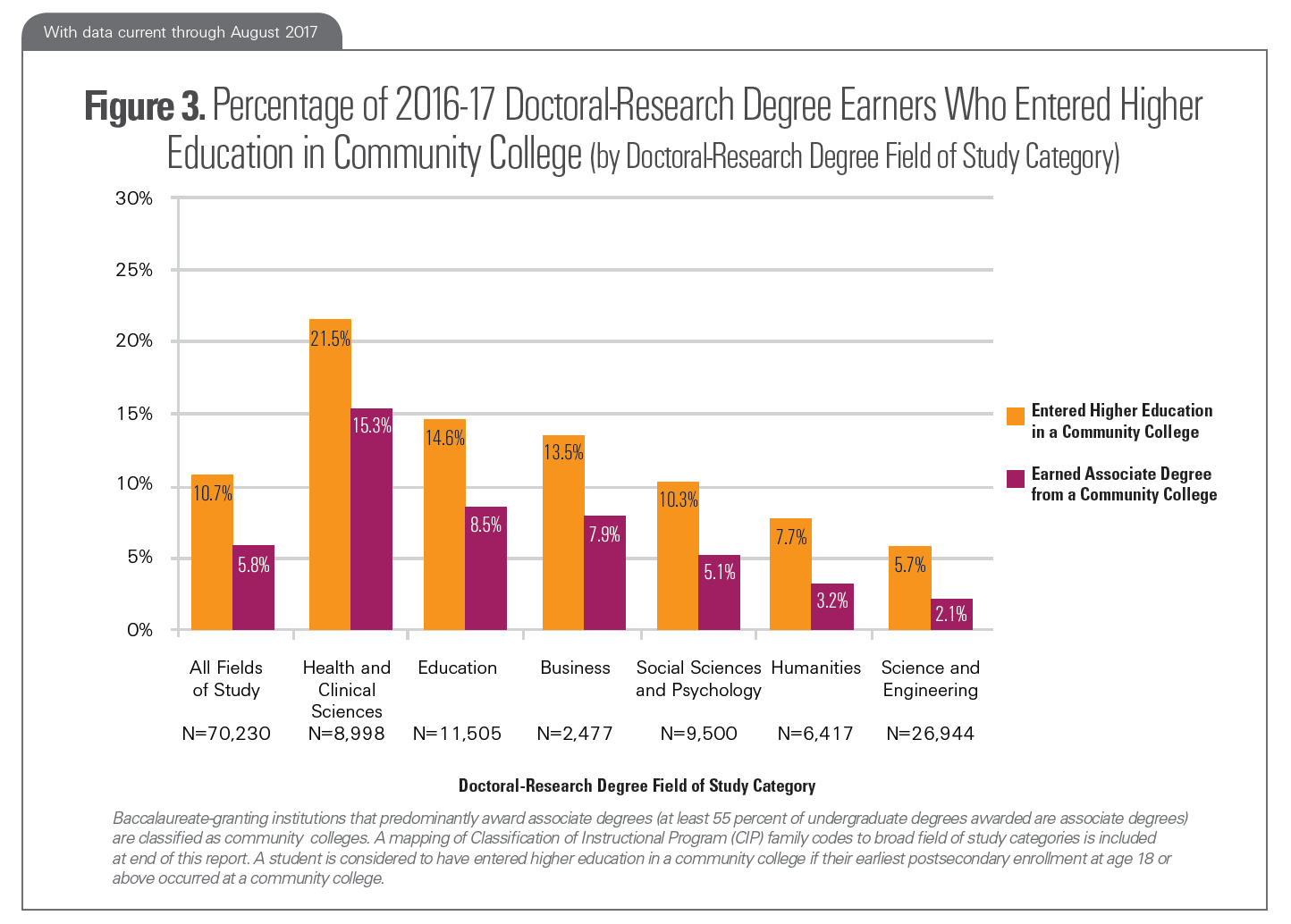
Years from Associate to Doctoral-Research Degree
For those students who earned both an associate degree and a doctoral-research degree, an average of 16 years separated the completion dates of the two credentials.
The longest timespans from associate to doctoral-research degree were in business and education. In these two fields, students earned a doctoral-research degree nearly 20 years after earning their associate degree, on average.
The shortest average timespan from associate to doctoral-research degree was in science and engineering (12.2 years).
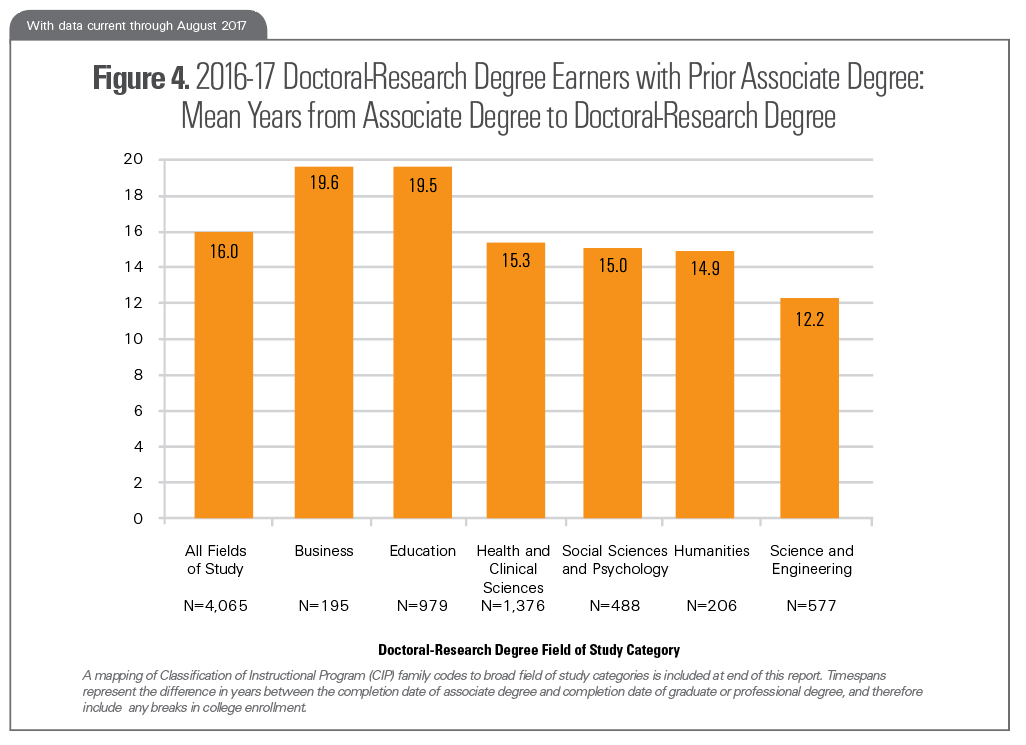
From Community College to Professional Degree
Over 13 percent of 2016-17 professional degree earners originally entered higher education in a community college, and almost six percent earned an associate degree from a community college.
Students who earned professional degrees in medicine were about as likely to have entered higher education in a community college as students who earned professional degrees in law.
Examples of professional degrees included here under the broad category of Medicine include: chiropractic (D.C. or D.C.M.); dentistry (D.D.S. or D.M.D.); medicine (M.D.); optometry (O.D.); osteopathic medicine (D.O); pharmacy (Pharm.D.); podiatry (D.P.M., Pod.D., D.P.); veterinary medicine (D.V.M.), and others, as designated by the awarding institution.
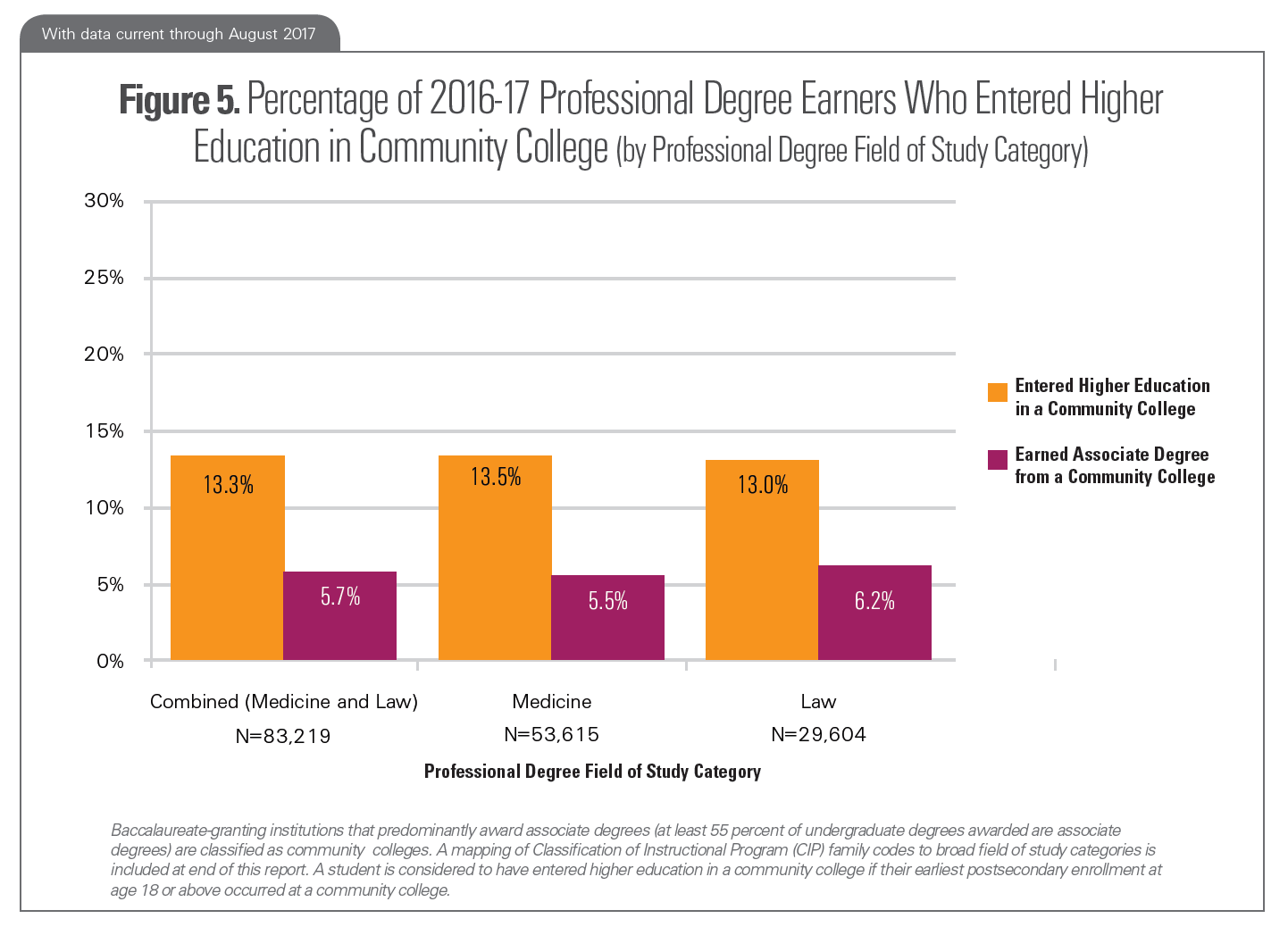
Years from Associate to Professional Degree
For students who earned both an associate degree and a professional degree, an average of eight years separated the completion
dates of the two credentials.
Notably, the average timespan from associate degree to professional degree (7.8 years) was shorter than both the average timespan from associate degree to master’s degree (9.9 years) and the average timespan from associate degree to doctoral-research degree (16.0 years).
This is one indication that students who enter higher education in community college and eventually earn professional degrees tend to persist in their postsecondary educations on a full-time basis and with few breaks in attendance.
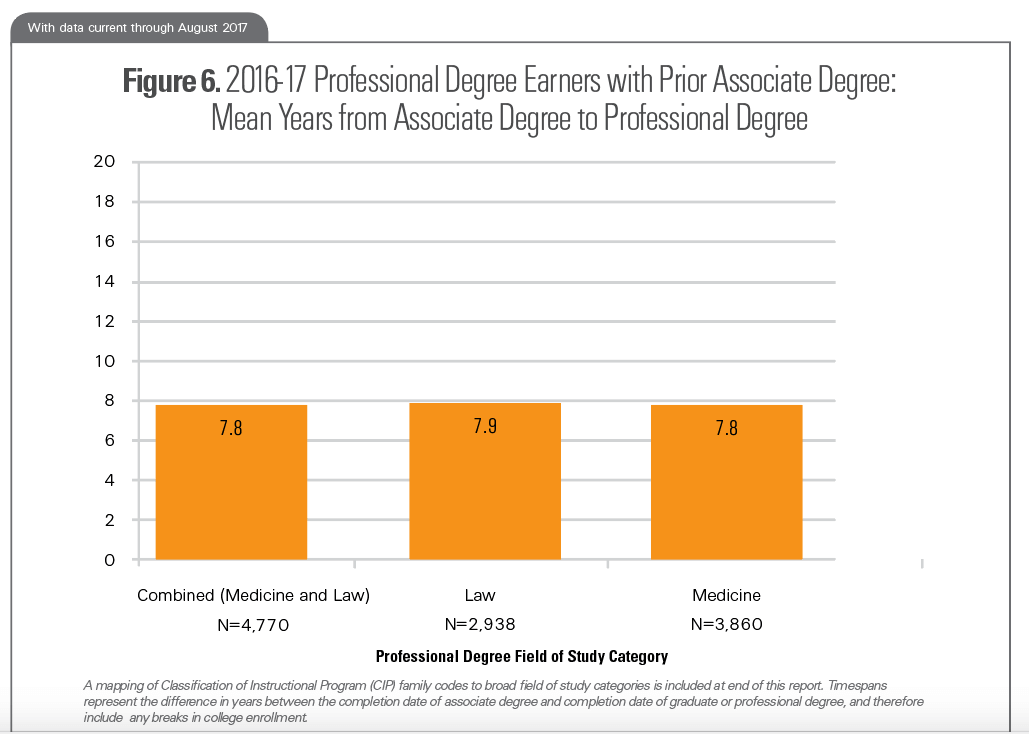
Field of Study Distributions
This figure shows the field of study distributions at each graduate and professional degree level, differentiating between students who entered higher education in community colleges and those who entered higher education in other institutions.
At the master’s and doctoral-research levels, the health and clinical sciences field is more prevalent among students who entered higher education in community colleges. Science and engineering, however, is far more prevalent among students who entered college in other institutions.
At the master’s and doctoral-research levels, education is also somewhat more prevalent among students who entered higher education in community colleges.
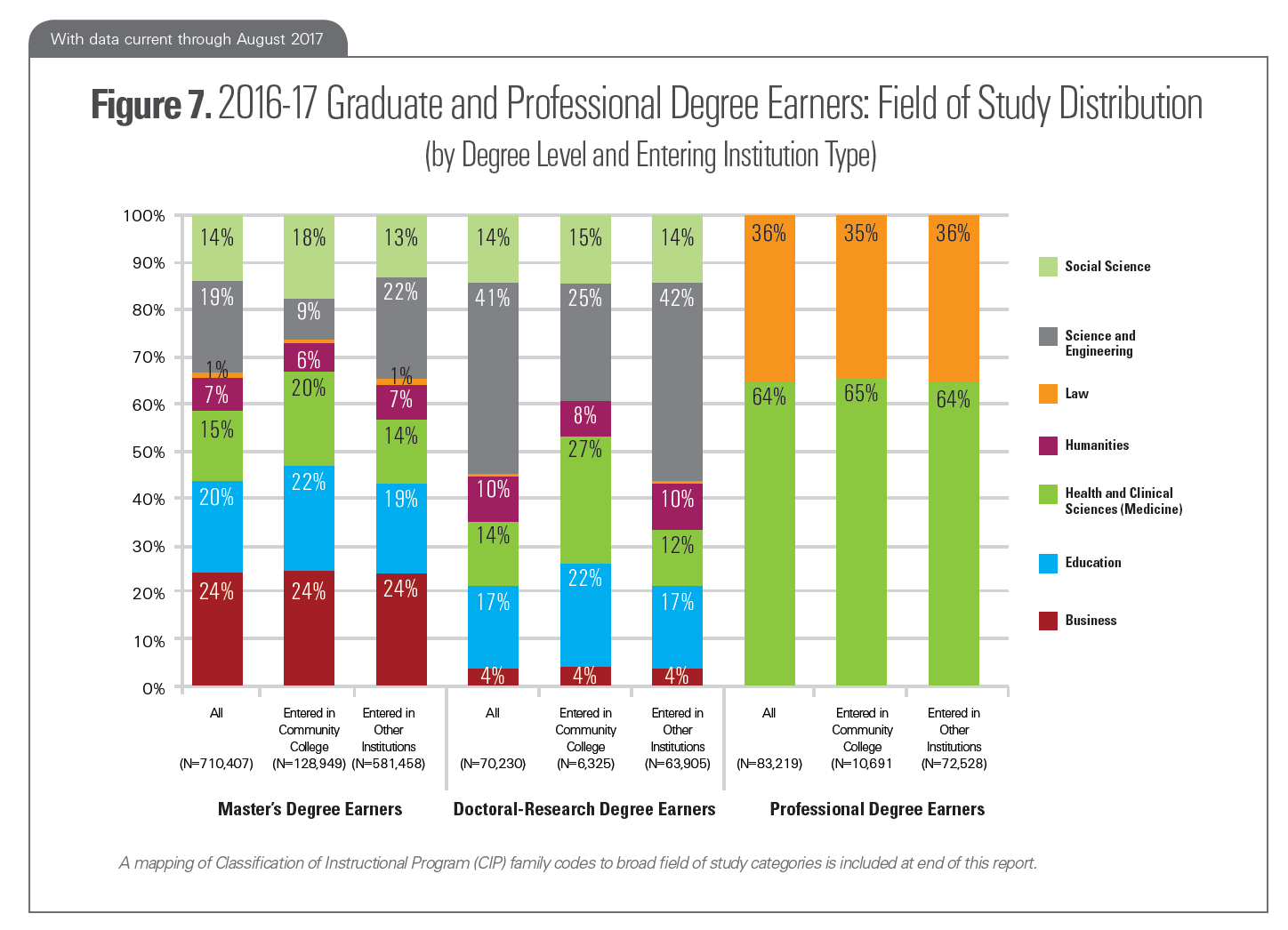
Additional Notes on the Data
Analysis in this report is based on credentials reported to the Clearinghouse through its DegreeVerify℠ service. The National Student Clearinghouse Research Center has estimated that credentials being reported through the DegreeVerify service account for 89 percent of associate degrees, 98 percent of bachelor’s degrees, 95 percent of master’s degrees, and 93 percent of doctoral degrees awarded in 2016-17. These estimates are based on comparing Clearinghouse degree counts to IPEDS degree counts for each degree level.
In this analysis, baccalaureate-granting institutions that predominantly award associate degrees (at least 55 percent of the undergraduate degrees awarded are associate degrees) are classified as community colleges.
A student is considered to have entered higher education in a community college if his or her earliest postsecondary enrollment at age 18 or above occurred at a community college.
In this report, counts of students who earned associate degrees from a community college are not limited to students who entered higher education at a community college.
Classification of Instructional Family codes were mapped to broad field of study categories according to the crosswalk on the following page of this report.
Crosswalk: Classification of Instructional Family Codes to Broad Field of Study Categories
|
CIP Family |
CIP Family Title |
Field of Study Category |
|
01 |
Agriculture, Agriculture Operations, and Related Sciences |
Other |
|
03 |
Natural Resources and Conservation |
Science and Engineering |
|
04 |
Architecture and Related Services |
Humanities |
|
05 |
Area, Ethnic, Cultural, and Gender Studies |
Social Sciences and Psychology |
|
09 |
Communication, Journalism, and Related Programs |
Social Sciences and Psychology |
|
10 |
Communications Technologies/Technicians and Support Services |
Social Sciences and Psychology |
|
11 |
Computer and Information Sciences and Support Services |
Science and Engineering |
|
12 |
Personal and Culinary Services |
Other |
|
13 |
Education |
Education |
|
14 |
Engineering |
Science and Engineering |
|
15 |
Engineering Technologies/Technicians |
Science and Engineering |
|
16 |
Foreign Languages, Literatures, and Linguistics |
Humanities |
|
19 |
Family and Consumer Sciences/Human Sciences |
Other |
|
22 |
Legal Professions and Studies |
Law |
|
23 |
English Language and Literature/Letters |
Humanities |
|
24 |
Liberal Arts and Sciences, General Studies and Humanities |
Humanities |
|
25 |
Library Science |
Other |
|
26 |
Biological and Biomedical Sciences |
Science and Engineering |
|
27 |
Mathematics and Statistics |
Science and Engineering |
|
28 |
Reserve Officer Training Corps (JROTC, ROTC) |
Other |
|
29 |
Military Technologies |
Other |
|
30 |
Multi/Interdisciplinary Studies |
Other |
|
31 |
Parks, Recreation, Leisure and Fitness Studies |
Other |
|
32 |
Basic Skills |
Other |
|
33 |
Citizenship Activities |
Other |
|
34 |
Health-Related Knowledge and Skills |
Other |
|
35 |
Interpersonal and Social Skills |
Other |
|
36 |
Leisure and Recreational Activities |
Other |
|
37 |
Personal Awareness and Self-Improvement |
Other |
|
38 |
Philosophy and Religious Studies |
Humanities |
|
39 |
Theology and Religious Vocations |
Humanities |
|
40 |
Physical Sciences |
Science and Engineering |
|
41 |
Science Technologies/Technicians |
Science and Engineering |
|
42 |
Psychology |
Social Sciences and Psychology |
|
43 |
Security and Protective Services |
Other |
|
44 |
Public Administration and Social Service Professions |
Social Sciences and Psychology |
|
45 |
Social Sciences |
Social Sciences and Psychology |
|
46 |
Construction Trades |
Other |
|
47 |
Mechanic and Repair Technologies/Technicians |
Other |
|
48 |
Precision Production |
Other |
|
49 |
Transportation and Materials Moving |
Other |
|
50 |
Visual and Performing Arts |
Humanities |
|
51 |
Health Professions and Related Clinical Sciences |
Health and Clinical Sciences |
|
52 |
Business, Management, Marketing, and Related Support |
Business |
|
53 |
High School/Secondary Diplomas and Certificates |
Other |
|
54 |
History |
Humanities |
|
60 |
Residency Programs |
Other |
